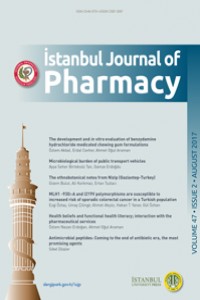Abstract
The goal of this study was to determine the
role of public transport in the transmission of microorganisms. A total of 60
swab samples were collected in the morning and evening from handles in public
transport trams, metrobuses, and buses. Swab samples were examined using
microbiological methods, and the number and types of microorganisms were
determined. Total aerobic bacterial and fungal counts in samples collected in
the evening were higher than those in samples collected in the morning from
trams and metrobuses. However, the total bacterial and fungal counts were very
high in samples collected in the morning and evening from buses. Staphylococcus
aureus, coagulase-negative staphylococcus, and Enterococcus spp. were isolated
from these samples. The results of our study show that public transportation
can be a significant reservoir for spreading pathogenic microorganisms. For
this reason, it is very important to regularly follow cleaning and hygiene
rules and to inspect these vehicles.
References
- REFERENCES • Bilgehan H (1992). Klinik Mikrobiyoloji Özel bakteriyoloji ve Bakteri İnfeksiyonları. Barış Yayınları Fakülteler Kitabevi, İzmir. • Brook J, Brook I (1994). Recovery of organisms from the handrails of escalators in the public metro rail system in Washington, D.C. J Environ Health 57: 13–14. • Edelson PJ, Phypers M (2011). TB transmission on public transportation: a review of published studies and recommendations for contact tracing. Travel Med Infect Dis 9: 27-31. https://doi.org/10.1016/j.tmaid.2010.11.001 PMid:21167784 • Furuya H (2007). Risk of transmission of airborne infection during train commute based on mathematical model. Environ Health Prev Med 12: 78–83. https://doi.org/10.1007/BF02898153 PMid:21431823 PMCid:PMC2723643 • French GL (2010). The continuing crisis in antibiotic resistance. Int J Antimicrob Agents 36: 3-7 https://doi.org/10.1016/S0924-8579(10)70003-0
- • Gürler B (2008). İstanbul Üniversitesi Tıp Fakültesi Tıbbi Mikrobiyoloji-3: Nobel Kitabevleri, İstanbul. • Otter JA, French GL (2012). Community-associated meticillin-resistant Staphylococcus aureus: the case for a genotypic definition. J Hosp Infect 81: 143-148. https://doi.org/10.1016/j.jhin.2012.04.009 PMid:22622448 • Rusin P, Maxwell S, Gerba C (2002). Comparative surface-to-hand and fingertip-to-mouth transfer efficiency of gram-positive bacteria, Diversity of Staphylococcus spp. in public transit 207 gram-negative bacteria, and phage. J Appl Microbiol 93: 585–592. https://doi.org/10.1046/j.1365-2672.2002.01734.x PMid:12234341 • Simoes RR, Aires-de-Sousa M, Conceicao T, Antunes F, Martins da Costa P Lencastre H (2011). High prevalence of EMRSA-15 in Portuguese public buses: a worrisome finding. PLoS One 6: 1-5. https://doi.org/10.1371/journal.pone.0017630 PMid:21407807 PMCid:PMC3047573 • Stepanovic S, Cirkovic I, Djukic S, Vukovic D, Svabic-Vlahovic M (2008). Public transport as a reservoir of methicillin-resistant staphylococci. Lett Appl Microbiol 47: 339-341. https://doi.org/10.1111/j.1472-765X.2008.02436.x PMid:19241530 • USP 32- NF 27. (2009) Microbial Limit Tests. The United States Pharmacopeia. • Winston LG, Chambers HF (2009). Antimicrobial resistance in Staphylococci: Mechanisms of resistance and clinical implications. Mayers D, (ed). Antimicrobial Drug Resistance Mechanisms of Drug Resistance. Vol.1, Humana Press, pp. 735-748. https://doi.org/10.1007/978-1-60327-595-8_4
- • Yatağan E (1991) Bulaşıcı Hastalıklar ve Epidemiyoloji. 2. Baskı, Sekav, İstanbul. • Zhou F, Wang Y (2013). Characteristics of antibiotic resistance of airborne Staphylococcus isolated from metro stations. Int J Environ Res Public Health 10: 2412-2426. https://doi.org/10.3390/ijerph10062412 PMid:23765189 PMCid:PMC3717744
Abstract
References
- REFERENCES • Bilgehan H (1992). Klinik Mikrobiyoloji Özel bakteriyoloji ve Bakteri İnfeksiyonları. Barış Yayınları Fakülteler Kitabevi, İzmir. • Brook J, Brook I (1994). Recovery of organisms from the handrails of escalators in the public metro rail system in Washington, D.C. J Environ Health 57: 13–14. • Edelson PJ, Phypers M (2011). TB transmission on public transportation: a review of published studies and recommendations for contact tracing. Travel Med Infect Dis 9: 27-31. https://doi.org/10.1016/j.tmaid.2010.11.001 PMid:21167784 • Furuya H (2007). Risk of transmission of airborne infection during train commute based on mathematical model. Environ Health Prev Med 12: 78–83. https://doi.org/10.1007/BF02898153 PMid:21431823 PMCid:PMC2723643 • French GL (2010). The continuing crisis in antibiotic resistance. Int J Antimicrob Agents 36: 3-7 https://doi.org/10.1016/S0924-8579(10)70003-0
- • Gürler B (2008). İstanbul Üniversitesi Tıp Fakültesi Tıbbi Mikrobiyoloji-3: Nobel Kitabevleri, İstanbul. • Otter JA, French GL (2012). Community-associated meticillin-resistant Staphylococcus aureus: the case for a genotypic definition. J Hosp Infect 81: 143-148. https://doi.org/10.1016/j.jhin.2012.04.009 PMid:22622448 • Rusin P, Maxwell S, Gerba C (2002). Comparative surface-to-hand and fingertip-to-mouth transfer efficiency of gram-positive bacteria, Diversity of Staphylococcus spp. in public transit 207 gram-negative bacteria, and phage. J Appl Microbiol 93: 585–592. https://doi.org/10.1046/j.1365-2672.2002.01734.x PMid:12234341 • Simoes RR, Aires-de-Sousa M, Conceicao T, Antunes F, Martins da Costa P Lencastre H (2011). High prevalence of EMRSA-15 in Portuguese public buses: a worrisome finding. PLoS One 6: 1-5. https://doi.org/10.1371/journal.pone.0017630 PMid:21407807 PMCid:PMC3047573 • Stepanovic S, Cirkovic I, Djukic S, Vukovic D, Svabic-Vlahovic M (2008). Public transport as a reservoir of methicillin-resistant staphylococci. Lett Appl Microbiol 47: 339-341. https://doi.org/10.1111/j.1472-765X.2008.02436.x PMid:19241530 • USP 32- NF 27. (2009) Microbial Limit Tests. The United States Pharmacopeia. • Winston LG, Chambers HF (2009). Antimicrobial resistance in Staphylococci: Mechanisms of resistance and clinical implications. Mayers D, (ed). Antimicrobial Drug Resistance Mechanisms of Drug Resistance. Vol.1, Humana Press, pp. 735-748. https://doi.org/10.1007/978-1-60327-595-8_4
- • Yatağan E (1991) Bulaşıcı Hastalıklar ve Epidemiyoloji. 2. Baskı, Sekav, İstanbul. • Zhou F, Wang Y (2013). Characteristics of antibiotic resistance of airborne Staphylococcus isolated from metro stations. Int J Environ Res Public Health 10: 2412-2426. https://doi.org/10.3390/ijerph10062412 PMid:23765189 PMCid:PMC3717744
Details
| Subjects | Pharmacology and Pharmaceutical Sciences |
|---|---|
| Journal Section | Original Article |
| Authors | |
| Publication Date | October 18, 2017 |
| Submission Date | October 18, 2017 |
| Published in Issue | Year 2017 Volume: 47 Issue: 2 |


